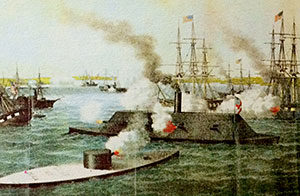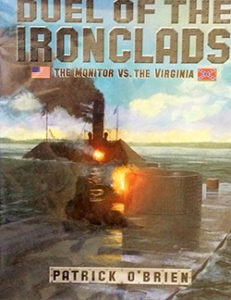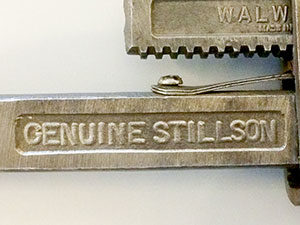 Eagle Feathers #108 – The Memory of a Lifetime
Eagle Feathers #108 – The Memory of a Lifetime
By Bob (Monty) Doherty
It was March 8, 1862. The location was near the mouth of the James River at Hampton Roads, Virginia. The Civil War was then raging, and the Union Navy commanded this position in order to protect Washington, D.C.
Suddenly, the most unusual vessel anyone had ever seen advanced toward the fleet and opened fire. It was the Confederate ship C.S.S. Virginia/U.S.S. Merrimack, a rebuilt, captured Union vessel. This steamer was not wooden like the vessels it was attacking, but entirely clad with two layers of two-inch heavy iron. While encountering the Union fleet, it sank the 24-gun U.S.S. Cumberland. It then caused the 50-gun U.S.S. Congress to run aground and burn.


After withdrawing, she intended to return in the morning to destroy the flagship U.S.S. Roanoke and the rest of the Union fleet. On arrival, she unexpectedly encountered the Union ship, the U.S.S. Monitor, the North’s newly built and only ironclad battle ship. This fighting machine, which was a turret on a platform, looked even less seafaring than the Confederate ship. The most important naval battle in American history up to that time was then played out. Thousands of spectators watched this historic engagement from the shore and the decks of other ships.

One of the frightened sailors viewing from the deck of the Union flagship, Roanoke, was its steam engineer, Daniel C. Stillson of Somerville. Stillson received his training at the Charlestown Navy Yard. He feared that if the small Monitor lost, then his ship would be next in line to be blown to bits by the larger Merrimack. The two ironclad ships cannonaded each other for over four hours to a standstill. Much of the fighting was at point-blank range; and in the end, the little Monitor saved her fleet. This epic American battle had worldwide ramifications because it put an end to wooden war ships that had ruled the seas for thousands of years. Dan Stillson later sailed under Admiral Farragut and survived the Civil War thanks to the “cheese box on a raft.”

After the war, Stillson easily got employment as a steam engineer back home. It was for J.J. Walworth & Company who had installed the steam heating system in the White House. Having worked in the Charlestown Navy Yard for years and as an engineer on four different ships during the war, he brought solid experience to the job. He built a house at 55 Tennyson Street on Winter Hill where he lived for the rest of his life. He served as a Somerville Alderman and Somerville Building Committee member. There is a plaque at the entrance to Somerville High School that brings notice to him; but one of his many inventions, by far, made his name more popular.

During the era of the birth of steam, many injuries were sustained while working on pipefitting. “Knuckle Busters “ was a common description for their tools back then, and Daniel’s invention put an end to these frequent injuries. Inspiration struck, and he designed a new, improved pipe-gripping device, the Stillson wrench. After almost 150 years of use, you would be hard pressed to find a shop in this country or most of the world that doesn’t still stock it. In addition, it would be difficult to find a dictionary or encyclopedia that doesn’t describe it.

Through his years, Dan, or “DC” as he was called, stayed close to the sea, vacationing on Cape Cod with his memories of the men of the Monitor and their cheese box on a raft that once saved his life.















Reader Comments